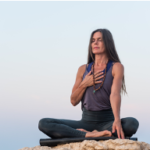The Tapestry of the Human Body Our Fascial Network
Categories: Uncategorized

By Suzanne Faith Slocum-Gori, PhD,
Certified Anusara® Yoga Teacher Bindu Yoga School
I continue to be in the utmost awe of how the human body and the inner heart operate together. With an infrastructure of 206 bones, the muscular-skeletal system is an integrated model of stability and movement. Our inner heart is nothing but a reflection of our personal awareness and collective consciousness. In order for our human form to optimally operate, it requires a beautiful matrix and web of facial networks and receptors which integrate the brain and nervous system.
Recently there has been a great deal of research conducted on the role of fascia in the overall health of the human body. In previous years, fascia was considered nothing more than a’ filler’ inside of us. But in actuality, fascia is an interwoven fabric of connectivity that holds together all of our many parts. Our fascial system incorporates all of the layers of soft and connective tissues, including all of our ligaments and tendons (Grilley, 2002). It is literally everywhere inside of you. It braids together all of your muscles, bones, organs, nerves, spinal cord, heart, lungs, brain and blood vessels into a network which cultivates an exquisite oneness.
Fascia is made of sensory nerve endings that are continuously in dialogue with the brain about where the body is located in space. This “inner lens” is called proprioception. This inner vision provides us with the capacity to move in a rational and controlled manner. The stronger your proprioception, the more effective our movements and nervous system will become.
According to Tom Myers (2011), this network of connective tissue is not only significant to our physical form, but also to our neurological system, brain chemistry, thoughts and emotions. Fascia is more than just a connective web but it also regulates, the same way that the circulatory and nervous systems operate, by carrying information, impulses and messages throughout the body. Fascia acts as an intricate communication network between all the systems and organs within the body. The interdependence of the fascial matrix means that the movements of our body cannot be separated. When one area of our body is negatively impacted (by poor posture, injury, emotional or physical stress), then the entire grid is influenced, which can trigger the brain to release stress inducing hormones, changing our internal chemistry and impacting our emotional state.
As ancient yoga scriptures outline, we know that the pranic body is an infrastructure made up of a meshwork of energetic channels referred to as nadis or meridians. These nadis reside within and throughout the fascial tapestry. It is critical for these pathways of vital energy to stay open and resilient. When the prana flows freely, so does the blood and the lymph systems (supporting immunity and organs). More specifically related to the inner-heart, our awareness also begins to flow more freely and expand.
The Asana (physical postures) can clear up the meridian pathways, allowing prana to organically move through connective tissues, joints, ligaments, tendons and skeletal system that may have become tight due to injuries, poor postural habits, repetitive stress or emotional trauma. In addition, the yogic breathing exercises (Pranayama) also have a massive interconnectedness with the healthiness of the fascial network and meridians. There are various breathing techniques which have a multitude of effects throughout our body, including the brain waves and nervous system. As Anusara teachers specifically, one of our primary aims is to invite students to experience and express their hearts through the yoga practices. It is through the study of Anusara Yoga that I cultivated a passion for how the physical and subtle bodies are bridged together. Anusara Yoga is a comprehensive approach to understanding the integrity of the human body and includes highly refined applications of teaching methods. Anusara Yoga cultivates a powerful connection with the Universal Divinity within each of us and celebrates our unique potentials. This is achieved in Anusara beyond the science of the asanas. We know from our lineage that the physical form dramatically impacts the inner body and vice-versa. Our aim is to align students with their Optimal Energetic Blueprint.
The Universal Principles of Alignment, the Focal Points, the Spirals and the Loops together construct a tapestry of interwoven channels of energy which bridge our physical and subtle bodies. We know that consciousness is a pulsation of energy, within our human essence but also all around us in physical manifestations. This rhythmic beat is often referred to as Spanda – the Universal drum beat of ParamSiva. We can also look at Spanda as the two primary Energies – Muscle Energy (inward moving, contracting) and Organic Energy (outward moving, expansive).
The essence of these two energies is Prana, which we find in our movement, breath, awareness and the Universal Heart.
As humans we are made up of interwoven sheaths that allow us to move from the physical realm into the inner world, closer and closer to the light of awareness. In Anusara our aim is to use the alignment of the outer form of the physical body to expand our inner body and move through the sheaths. We want to invite students to experience a variety of sensations at the mind-heart level, including courage, playfulness, steadfastness, devotion and integrity. Our purpose as Anusara teachers is to invoke the experience of each sheath. The fascial web of connectivity provides a pathway to connect all of our layers.
The more we as Anusara teachers enhance our skills and understanding of anatomy, proprioception, the fascial system and the architecture of subtle body, the more refined our studentship and teaching becomes. Furthermore, and even more importantly, it means the more we can invite our students to celebrate and welcome their wholeness and oneness.
Bibliography
Myers, T. (2011), Anatomy Trains, Urban & Fischer, London.
Grilley,P., (2002), Yin Yoga, White Cloud Press.




